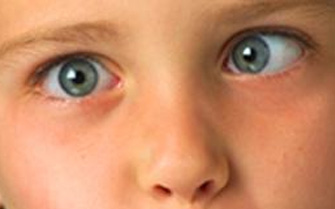AMBLYOPIA or LAZY EYE
What is amblyopia?
 Amblyopia is poor vision in an eye that did not develop normal sight during early childhood. It is sometimes called "lazy eye." When one eye develops good vision while the other does not, the eye with poorer vision is called amblyopic. Usually, only one eye is affected by amblyopia. The condition is common, affecting approximately 2 or 3 out of every 100 people. The best time to correct amblyopia is during infancy or early childhood. Parents must be aware of this potential problem if they want to protect their child's vision.
Amblyopia is poor vision in an eye that did not develop normal sight during early childhood. It is sometimes called "lazy eye." When one eye develops good vision while the other does not, the eye with poorer vision is called amblyopic. Usually, only one eye is affected by amblyopia. The condition is common, affecting approximately 2 or 3 out of every 100 people. The best time to correct amblyopia is during infancy or early childhood. Parents must be aware of this potential problem if they want to protect their child's vision.
What are the Causes?
Amblyopia is caused by any condition that affects normal use of the eyes and visual development. In many cases, the conditions associated with amblyopia may be inherited. An ophthalmologist early in life should check children in a family with a history of amblyopia or misaligned eyes. Amblyopia has three major causes:
- Squint: Amblyopia occurs most commonly with misaligned or crossed eyes. The crossed eye "turns off" to avoid double vision and the child uses only the better eye.
- Refractive errors: Refractive errors are eye conditions where in the rays of light are not focused clearly on the retina (the layer responsible for catching the image & sending it to the brain). They are corrected by wearing glasses. Amblyopia occurs when one eye is out of focus because it is more nearsighted, farsighted or astigmatic than the other. The unfocused (blurred) eye "turns off" and becomes amblyopic. The eyes can look normal but one eye has poor vision. This is the most difficult type of amblyopia to detect and requires careful measurement of vision.
- Cloudiness in the normally clear eye tissues (cataract, scar in the cornea etc.)
All these disorders will prevent clear focusing of the light in the eye. Hence the child will not use that eye. To give a simple analogy, imagine you have a fracture in one of your arm & it is tied up with a plaster for 3 months. Once the plaster is removed after 3 months, you will feel you have that the arm has lost its power since the muscles have become weak (disuse atrophy). Similarly if you don't use one eye for few months or years in childhood, that eye becomes weak & looses vision. This is called as Amblyopia.
How is amblyopia diagnosed?
It is not easy to recognize amblyopia. Unless the child has a misaligned eye or other obvious abnormality, there is often no way for parents to tell that something is wrong. Amblyopia is detected by finding a difference in vision between the two eyes. Since it is difficult to measure vision in young children, your ophthalmologist often estimates visual acuity by watching how well a baby follows objects with one eye when the other eye is covered. If one eye is amblyopic and the good eye is covered, the baby may attempt to look around the patch, try to pull it off or cry.
How is it treated?
Because there are several causes of amblyopia, the treatment depends on the problem. Glasses will correct the problem in some. Surgery may be needed for cataracts, droopy eyelids or crossed eyes. After the cause of the amblyopia is found, the child will need to use the weaker eye most of the time, so that it will get stronger. To make the child use the weaker eye, a patch can be put over the stronger eye. Rarely, eye drops or special glasses are used to blur the vision in the stronger eye. This makes the weaker eye become stronger. Patches may be used all day or part of the day, depending on the child's age and vision. The treatment usually lasts until vision is normal, or until vision stops getting better. For most children, this takes several weeks. A few children need to use eye patches until they are 8 to 10 years old.
Importance of early treatment:
The vision pathways in the brain must become strong early, when children are very young. The first few years of life are the most important for eyesight. After a child is 8 to 10, the brain's vision system is complete. It can't develop anymore. If the amblyopia hasn't been treated by this age, the child will have poor vision for life. It won't be possible to fix it with glasses, patching or any other treatment.
There's a small chance that using an eye patch for too long can hurt the strong eye. For this reason, children who are wearing eye patches should see their doctor often during the treatment.
Prevention:
It is not easy to recognize amblyopia. A child may not be aware of having one normal eye and one weak eye. Unless the child has a misaligned eye or other obvious abnormality, there is often no way for parents to tell that something is wrong. Hence it is extremely important for children to have an eye examination once at birth & then once before starting schooling. It is a myth that a child's eye cannot be examined unless he/ she is familiar with alphabets. An ophthalmologist can pick up amblyopia & assess the refraction even in a infant ( less than one year of age).

